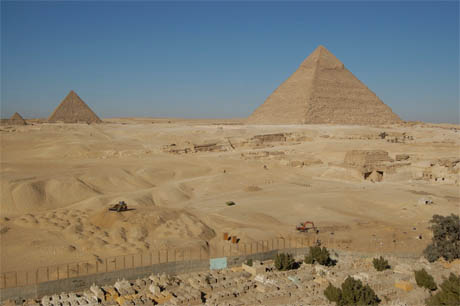Posted by Ana Tavares, Joint Field Director
With the New Year we open a new excavation season in Giza. We have been preparing for weeks: equipment, archives, travel, and housing. Traditionally, we started on site soon after the Coptic Christmas Holiday on 7th of January. We spent a week removing the protective sand we had left at the end of our previous seasons from four excavation areas in readiness for the team. Saied Salah, our Reis (overseer of workmen), monitored and photographed the entire process, which ranges from removing modern thick, sand deposits, to light trowelling of delicate areas.

The Giza plateau viewed from the southern knoll, view to the northwest. The Khentkawes and Menkaure Valley Temple excavation areas are on the bottom left beyond the modern cemetery and trees. Photo by Yasser Mahmoud.
This season we have, essentially, an Egyptian team. This is the culmination of many seasons, when Supreme Council of Antiquities (SCA) archaeologists have joined the AERA Giza team, working side by side with foreigners. This process was accelerated with the AERA/ARCE* field-schools, which we have been running since 2005. The Egyptian graduates, in archaeology, survey, ceramics, illustration, osteology, became teachers and now run aspects of the field-school themselves. This season, just two months after we completed the Mit Rahina Beginners’ field-school, we are running a ‘training-on-the-job’ programme for Giza SCA Inspectors.

Hanan Mahmoud, in charge of the excavations in the Menkaure Valley Temple, explains the area to her team. Photo by Yasser Mahmoud.
We are excavating in both in the workers settlement Heit el Ghurab (Lost City) and in the Khentkawes/Menkaure area. In the workers settlement we investigate Gallery III.3. We hypothesize that the galleries are barracks for housing the pyramid builders (https://www.aeraweb.org/lost-city-project/royal-guard/). Exactly ten years ago, Ashraf Abdel Aziz excavated one gallery in its entirety (https://www.aeraweb.org/publications/monographs/ ). This season we investigate the adjacent gallery to test our ideas about the construction sequence and the elements which constitute a gallery.

Gallery GIII.4, excavated in 2002 by Ashraf Abdel Aziz (sitting on the left) has enough room to house 40 workers. View to the north. Photo by Mark Lehner.
In the town of Queen Khetkawes we continue the recording of Priests’ houses, built along the causeway linking the Queen’s funerary monument to a ‘Valley Temple’ and basin. Last season, we found, to the east of the basin, a series of silos and rooms, possibly magazines (https://www.aeraweb.org/wp-content/uploads/2011/07/AG%2012.1.pdf). We plan to work in both these areas.
In the upper town the recording of Houses A, B and C, excavated by Selim Hassan in the 1930s, would bring to near completion our meticulous recording of the Khetkawes settlement. In the lower town we investigate the stratigraphic link between the Silo building and the basin.

First day - the team arrives on site as workers remove the sand protecting the Silo Building. The Khentkawes basin is now filled with water due to the rising water table. In the background, closer to the Queen’s stepped monument, is our mudbrick reconstruction of a priest’s house. View to the west. Photo by Yasser Mahmoud.
To the south of the Khentkawes settlement we continue work in the Menkaure Valley Temple. Here we investigate the magazines to the north and south of the main temple vestibule (vestibule 2, Reisner ‘s 377). Over a hundred years ago George Reisner excavated and identified a complex sequence of the temple rebuilds and at least three distinct phases of a settlement which developed inside the temple walls. Last season we recorded a ‘middle temple phase’, which enriches our understanding of the life of this structure. This season we test, and hope to expand, these findings.

Four imposing alabaster column bases in the vestibule of the Menkaure Valley Temple. The team is recording at the end of last season in March 2011. View to the northeast. Photo By Mark Lehner
So, with the New Year the AERA Center comes to life: groups of archaeologists pour over maps and collect archives for their excavation areas; the surveyors and photographer prepare their equipment; the ceramicists discuss recording strategies; the house staff run around assembling yet more electrical extension cords; while the cooks wonder how they will ever feed so many people…
What a great way to start the year!
